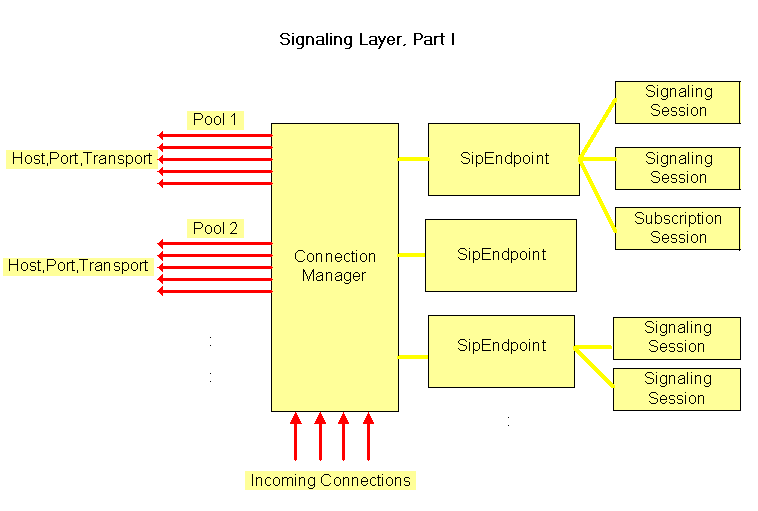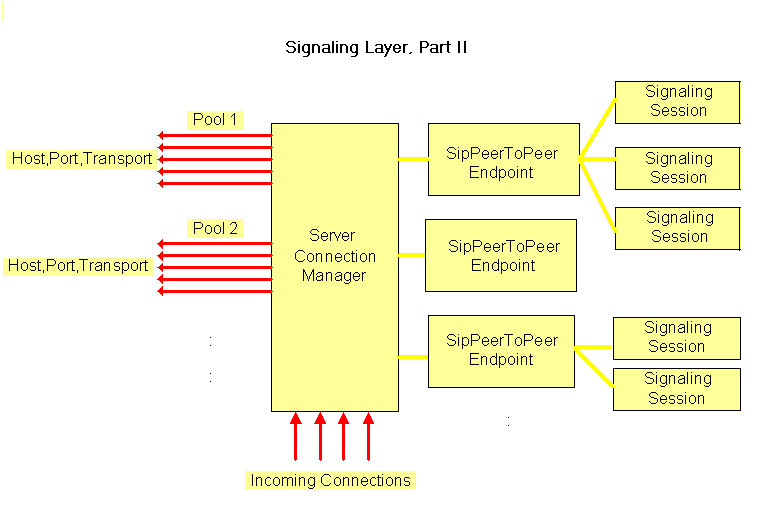The Unified Communications Managed API version 1.0 Signaling layer manages connections and sessions with other remote endpoints or with a SIP Proxy. It can also host from one to several thousand User Agent endpoints. The implementation supports low-level session management including establishing and maintaining two-party signaling sessions, connection management including connection sharing for outgoing connections and message dispatching for incoming connections, and basic online subscription sessions in which one party subscribes to data or its update published by another party. In addition, the Unified Communications Managed API version 1.0 Signaling layer also supports page-mode messaging to send messages without using any sessions. The Unified Communications infrastructure implements an object model for the most common SIP scenarios. The Unified Communications Managed API version 1.0 Signaling layer is independent of upper layer Microsoft Office Communications Server 2007-specific and Office Communicator-specific semantics.
 Architecture Using SipEndpoint
Endpoints
Architecture Using SipEndpoint
Endpoints
The following illustration shows the architecture of the Unified Communications Managed API version 1.0 Signaling layer.

The preceding illustration shows the situation where an endpoint is represented by a SipEndpoint. Typically, such an endpoint registers with a SIP server to communicate with other endpoints of this type. The endpoint can be used with either a client or server connection manager.
 Architecture Using
SipPeerToPeerEndpoint Endpoints
Architecture Using
SipPeerToPeerEndpoint Endpoints
The following illustration illustrates the situation where a SipPeerToPeerEndpoint is used. A peer-to-peer endpoint does not register with a SIP server to communicate with other peer-to-peer endpoints and can be used only with a server connection manager.

 Client Throttling and Server
Throttling
Client Throttling and Server
Throttling
To help an application meet its scalability requirements, Unified Communications Managed API version 1.0 provides client and server throttling on endpoints, as well as connection pooling.
Client throttling limits the number of SIP requests that come from a single endpoint. When client throttling is in effect on an endpoint, Office Communications Server 2007 fails new SIP requests that come from a particular endpoint if the number of outstanding SIP requests on the server from that endpoint reaches a predetermined limit (currently 20). Acting as a helper, Unified Communications Managed API version 1.0 Signaling also enforces throttling for a SipEndpoint whose IsEndpointThrottled property is true. An application that uses SipEndpoint endpoints (and particularly one that implements an IM bot scenario), should set IsEndpointThrottled to false so that Unified Communications Managed API version 1.0 Signaling does not throttle SIP requests locally. In this case, the application host server should have its FQDN added to the list of authorized Office Communications Server 2007 hosts.
 Note: Note: |
|---|
| Unified Communications Managed API version 1.0 Signaling does not throttle SIP requests from SipPeerToPeerEndpoint instances. |
Server throttling is essentially no throttling, as far as SIP requests are concerned. When server throttling is in effect on an endpoint, Office Communication Server 2007 does not enforce any limits on the number of outstanding SIP requests. IsEndpointThrottled being set to false usually implies that server throttling is turned on.
 In This Section
In This Section
 See Also
See Also
Concepts
Unified Communications Managed API version 1.0 ArchitectureDevelopment Guide for Unified Communications Managed API version 1.0
Unified Communications Managed API version 1.0 Object Model
 See Also
See Also 
